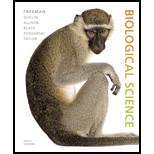
Concept explainers
Choose the best definition of a fossil.
a. any trace of an organism that has been converted into rock
b. a bone, tooth, shell, or other hard part of an organism that has been preserved
c. any trace of an organism that lived in the past
d. any part of a dead organism
Introduction:
The shells, bones, teeth, hair, exoskeletons, or stone imprints are included in the fossils. They are studied for their age, formation process, and significance in evolution. The study of the fossil is called paleontology and the totality of fossil is termed as fossil records.
Answer to Problem 1TYK
Correct answer:
The fossil is any trace of an organism that lived in the past. The preserved remains or traces of any part or whole of an organism that was once living, are called fossils.
Explanation of Solution
Explanation/Justification for the correct answer:
Option (c) is given as any organism traces that lived in the past. The fossil can be explained as the remains or traces of an organism, which was once living. The fossils are the physical proof or evidence that gives information about the organisms that once lived in the past. Hence, option (c) is correct.
Explanation for incorrect answers:
Option (a) is given as any organism’s traces that are converted into rocks. These are formed when a part or the whole organism gets buried under a lot of pressure in the sand, mud, or ash. The course of time causes mineralization of the organism, which then turns into fossils. So, it is an incorrect option.
Option (b) is given as any hard parts that have been preserved. Soft parts of the organisms that are preserved can also be considered as fossilized remains. So, it is an incorrect option.
Option (d) is given as any part of a dead organism. It is not necessary that only a dead organism that has been preserved may be described as a fossil. So, it is an incorrect option.
Hence, options (a), (b), and (d) are incorrect.
The hard traces or remains of an organism that had once lived in the past, like bones, teeth, and shells get converted into rocks. The soft traces like hair are also preserved but not in the form of a rock. Thus, the fossil is any part of the dead organism that has been preserved, and which serves as a trace to study that organism.
Want to see more full solutions like this?
Chapter 25 Solutions
Biological Science (6th Edition)
- Which mechanism of fossil formation created a replica of an organism's original form? a natural cast b amber-preserved c permineralization d trace fossilarrow_forwardIn which type of rock are you most likely to find a fossil? a. basalt, a dark, fine-grained volcanic rock b. limestone, composed of sedimented calcium carbonate c. slate, a volcanically melted and cooled shale d. granite, which forms by crystallization of magma cooling below Earth’s surfacearrow_forwardHow do we know how old a fossil is? A) We compare it to current species and see how much has changed B) We see how much soil is on top of it C) We use radiometric datingarrow_forward
- List 5 examples of types of fossils.arrow_forwardChoose the best below ? Which of these steps probably occurred first in the chemical andbiological evolution of life? a. The cell membrane of a protobiont formed.b. Formation of the first organic moleculesc. The genetic material was RNA.d. Simple organic monomers formed from inorganic materials.arrow_forwardOrganisms that are closer together on a cladograma. are in the same family.b. comprise an outgroup.c. share a more recent common ancestor than those organisms that are farther apart.d. share fewer derived characters than organisms that are farther apart.arrow_forward
- Why are indices better than simple measurements for comparing fossil specimensarrow_forwardWhich of the following was not present by the end of Precambrian? a. archaea c. fungi b. bacteria d. fisharrow_forwardhow does examining the depth in which fossil is found in the ground, help scientists understand more about organism it once belonged to?arrow_forward
- One type of fish fossil is found only in a rock layer near the bottom of a canyon, while a different kind of fish fossil is found only in a rock layer 4,000 feet higher, near the top of the canyon. Which statement would a scientist most likely offer to explain this situation? A.) The fish in the lower layer lived in the deep sea. While the other fish lived in shallow water. B.) The fish in the upper layer lived a healthier life than the other fish. C.) The rock in the lower layer is denser than the rock in the upper layer D.) The rock in the upper layer must have formed in freshwater E.) The fish in the upper layer lived more recently than the other fish. The Geologic Time Scale is a systematic chronological dating process that relates geological strata to time. This methodology is commonly used be geologists, paleontologists, and other Earth scientists to describe the timing and relationships of events that once occurred in history. Which of the following statements can be…arrow_forwardWhat is the study of fossils called? Mention any three points how the fossils throw light on past life?arrow_forwardFossils found in deeper layers of the Earth generally have ____ 14C than fossils found in the upper layers. a. more c. the same amount of b. less d. different types ofarrow_forward
